

| Glow Worms - a detailed summary 2009 |
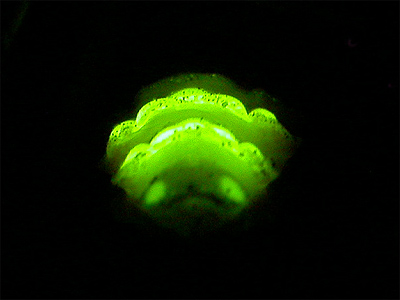 |
2009 provided us with an
excellent opportunity for much more detailed study than
was possible in 2008 and is summarised in detail here. From the end of May and into early August, each female was given a number and it's location marked, meaning that by the end of the glowing season, we had recorded a total of 385 females and gained much more of an insight into the lives of each female. All the observations summarised here, relate to Clipstone Old Quarter, which borders part of the Sherwood Forest NNR. Visits to record females were made on every night between May 21st and August 5th. This corresponds to a total of 76 nights, several of which were extremely wet, but on the whole, we were very fortunate with the weather during the period. |
|
| ........ | ||
| Visits to
Clipstone Old Quarter during the 2008 season were
relatively inconsistant, when there was often several
days between visits, partly due to us monitoring Glow
Worms at Sherwood Heath and also checking for Glow Worms
at other suitable sites in the area. We marked no females
during the course of 2008, and were left with the
assumptions that females glowed for much longer time
periods (often four to five nights or more) and that if a
female failed to glow one night, then reappeared at the
same location, then it would be a different female. We
did however, notice that wet weather played a factor in
the glowing of females, in that they often failed to glow
on evenings following days that had been wet, or were wet
during the actual period of counting. These were just basic field observations, noticed through an increasing familiarity with Glow Worms, that we developed throughout the course of 2008. The Spring and Summer of 2009, proved to us that whilst casual observations and notes could generally be relied upon, more detailed study revealed that there was far more to the glowing habits of this extraordinary beetle, than we had previously supposed. |
||
| ... | ||
| The 2009 glowing season
got off to a surprisingly early start at Clipstone Old
Quarter. We began searching for adults continuously from
May 21st, but it was to be six evenings later before we
found our first on May 27th, when two females were found
within five metres of each other on the edge of a large
forest track (Photograph 04) The track runs north/south downhill, before turning and continuing level west. The corner of this track probably represents the warmest section of the site. It has full exposure to the sun and this could be the reason as to why several of the first females were found in this area. Our first two females were the third UK record for 2009, following females at Kerne Bridge in Herefordshire on May 15th and at Maiden Newton in Dorset on May 26th * (Source:- UK Glow Worm Survey) |
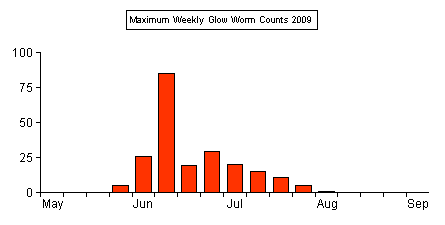 |
|
| ... | ||
| Many of the
early females came from locations along this track,
before any real numbers were being recorded from the wide
grass strip on site. There is the potential for more work
to be done to determine or confirm any correlation
between female emergence on dry track habitat, to that of
female emergence within the more moist, grass habitat.
The correlation seemed perfectly obvious to us during the
course of the season, as did emergences in conditions of
extreme shade, which accounted for a surprising later
surge in emergences from around June 25th. During the course of the season, there were multiple female emergences within relatively small areas of the site. One of the densest congregations of female emergences/records came quite early in June, with many females found in the area shown on Photograph 01. This area was active till mid-June, with just two females noted after this period and none at all from June 25th onwards. This section is open to the sun and is often very warm, but at night, temperatures can drop if a low mist develops. Interestingly, we recorded very few Glow Worms from this area of track in 2008. |
||
| ... | ||
| Photograph 01 Section of Clipstone Old Quarter that produced a large number of females during the first weeks of June. We recorded very few Glow Worms from this area in 2008. | Photograph 02 Area of Clipstone Old Quarter which remains in dense shade throughout the late Spring and through the Summer. Good numbers of females appeared in this habitat from June 25th, continuing into July. | |
| ... | ||
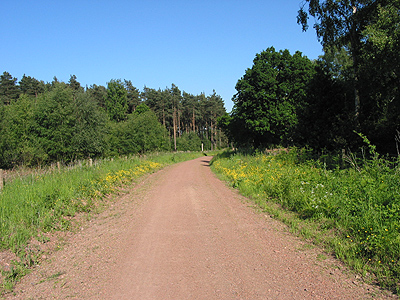 |
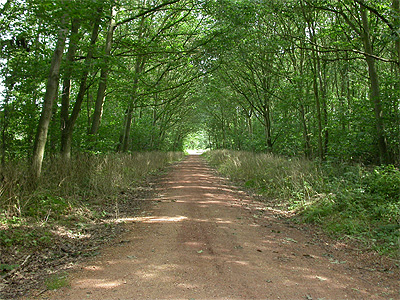 |
|
| ... | ||
| The section
of Clipstone Old Quarter shown in Photograph 02, provided
an unexpected series of new females in the last week of
June. By this time, it was often possible to walk the
length of the site, knowing there would be no Glow Worms
before reaching this area, unless another section was
starting to provide records. This grouping of females in
particular areas, was extremely evident throughout most
of the season. Another unexpected aspect, was to find Glow Worms in an area of dense shade and amongst leaf litter (Photograph 03) which was not the type of habitat we had expected to find them in. This area was the darkest on site and along the forest track, the tree canopy almost spans the width of the path. Along this track, females were often found near the middle of the path, suggesting that many females consciously make the effort to find the most open aspect for glowing, using available twilight through gaps in the tree canopy as a guide to the most open position. |
||
| ... | ||
| Photograph 03 Area of dense shade, as shown in Photograph 02. We were surprised to find Glow Worms in this habitat, including one over a metre up the trunk of a tree on one occasion. | Photograph 04 Section of Clipstone Old Quarter which produced the first females of 2009. This is probably the warmest area of the site, which may account for the faster development of larvae during the Winter/Spring and early adults. | |
| ... | ||
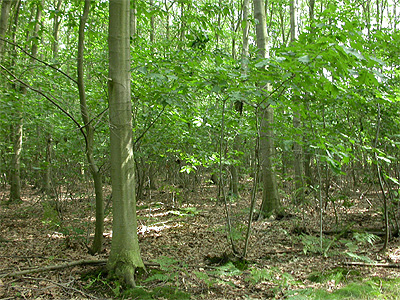 |
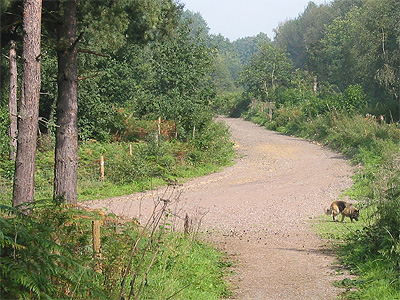 |
|
| ... | ||
| Any movement of females from night to night was always minimal and in most cases there was no movement at all. Only a handful of females out of a final total of 385, were found to have moved more than a metre, but this usually only applied to females that glowed for a week or more. Females 15 and 382 both moved about three metres from their original locations and were the only females which could be classified as having moved any distance. Female 15 gradually moved over the course of the 13 nights she glowed, but Female 382 moved directly across a path from one evening to the next, where she remained in situ for over a week. This represented the clearest example of a female deliberately changing locations in a fresh attempt to attract a mate. Of course not all females seemed to be careful in their choice of glowing location, as some females were found glowing deep within dense areas of Bracken. These often remained either unmated, or glowed for long periods during the peak time for males without attracting one. | ||
| ... | ||
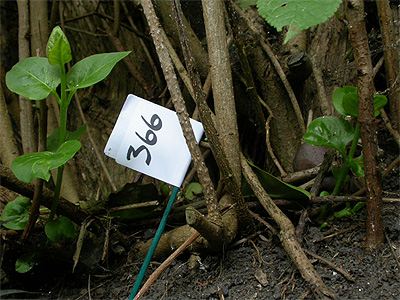 |
A simple label with
number was used to mark female locations. Marking, whilst
helping to determine their movements, also helped to
prove that most females hatched and were mated within two
days. If all female emergences occurred during the
afternoon (as in the case of one larva we reared to
maturity in captivity) the first 24 hours of a newly
hatched female were spent hardening off and glowing would
begin the following evening after emergence. Because of
this, it is possible to assume that all females lived for
a day longer than the number of nights they actually
glowed for. Successful mating would most likely take place the first night a female actually glowed, but we did find some variation in this during the glowing season. Early and late emerging females, were less likely to be mated on the first evening and based on the number of females that did glow for just one evening, it was possible to determine when the highest number of males occurred. Peak male activity occurred from June 10-30th, which in 2009 was directly within the middle of the glowing season. |
|
| ... | ||
|
Table 01 shows the total
number of females and the corresponding percentage of
females, that were recorded on just one evening during
the course of the season. As throughout the season, we
broke females down into groups of 50s, to help with
analysis at the end of the year. A high percentage of
72.0% of females were mated the first evening during the
middle of the season, when the number of males in flight,
must have been at it's greatest. The table also shows
that much lower percentages of females were mated the
first evening, at both the beginning and end of the
season. On June 7-8th, a large emergence took place with 63 new females appearing on the latter date. Of this total, just over 90% were mated and had stopped glowing after three evenings. |
||||||||||||||||||||||||||||||||||||||||||||||||||||||||||||||||||||||||||||
| ... | |||||||||||||||||||||||||||||||||||||||||||||||||||||||||||||||||||||||||||||
|
In Table 02, a similar
mid-season peak in the percentage of females that glowed
for two evenings is not produced, probably due to lower
numbers of males at this time, leading to many females
being mated on the first evening. The total numbers of females recorded glowing for three evenings are shown in Table 03. It is interesting to note how relatively constant the percentage rate is during the middle of the season in comparison to the other tables, only ranging between 4.0% and 10.0%. The lower percentages early and late in the season are caused by a higher number of females glowing for longer than three evenings, although the figures for Females 350-385, would have been expected to be the lowest, through many of these remaining unmated, as the number of males dropped. |
||||||||||||||||||||||||||||||||||||||||||||||||||||||||||||||||||||||||||||
| ... | |||||||||||||||||||||||||||||||||||||||||||||||||||||||||||||||||||||||||||||
|
|
||||||||||||||||||||||||||||||||||||||||||||||||||||||||||||||||||||||||||||
| ... | ||
| In Table 04,
the average glowing length measured in evenings are
produced. This table does show the gradual shortening of
glowing periods as numbers peaked, becoming much longer
by the end of the season, when there were some
unexpetedly long-glowing females. Female longevity only really became evident after most males had died off. Generally, it seems that the number of males declined rapidly from July 5th, with only one other male being found with a female after this date. This was also confirmed visually, as we rarely saw any of the short-lived glows exhibited by males in flight after late June and into early July. Females which emerged after July 5th, were another aid in determining that there were very few males in flight, simply by the increase in the number of evenings spent glowing. Even females which glowed from the grass strip, which has the most open aspect on site and the ideal location from which to attract a male, failed to attract one after this date. Consequently, there were several females that were recorded glowing for unexpectedly lengthy durations. A period of about 14 days (nights) is considered average, but we recorded several females glowing well in excess of this. Most remarkable was Female 382, recorded glowing over a 24 evening period. This was quite a staggering figure, as this was a small female in comparison to many others almost double her size. Other especially long lived females included Females 366 (20 evenings) and Female 371 (22 evenings) but there were numerous other females late in the season, that failed to attract a male. |
||
| ... | ||
| Female 382 showed
incredible longevity, eventually becoming the last Glow
Worm of 2009 and after failing to glow on July 28th, we
believed she had stopped glowing. A few evenings later
though, we found her in her usual location whilst
searching for larvae, where she continued to glow for a
further three evenings. This was quite remarkable, as she
had not been seen for four consequtive evenings during a
wet spell of weather. Female 382 clearly never mated and on her last few night, only glowed very dimly. She became increasingly mobile over a very small area, before she finally stopped glowing on August 5th and wandered off as we watched her. She was not recorded on any subsequent visits to the site. It was impossible to estimate how many females actually did fail to attract a mate, but one sure indication that a female was going to stop glowing un-mated, would be a sudden change in position by at least a metre on the last night seen glowing and then often glowing dimly. Continuously dim glowing females were occasionally recorded throughout the course of the season. |
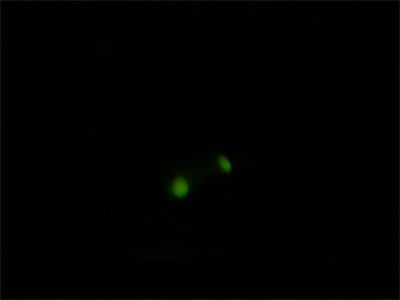 |
|
| ... | ||
| In all, there were five
females which fell into this category and at least two of
these never attracted a mate. All dim glowing females
were notably small and were found in the second half of
the season. Females 248, 277, 293, 364 and 381 sometimes
glowed so faint, that unless you knew the location, they
would have been very difficult to find at all.
Photographs showed that the glowing plates of these
females, either only just worked, or did'nt work at all.
The upper right photograph shows the glowing plates of
Female 277, compared to those of a typical glowing female
(lower right) taken at Clipstone Old Quarter in 2008. The weather was never a factor in causing females to glow dimly, although it certainly was a cause for females to sometimes not glow at all. But even then, we found this to be rather dependant on date. In June, the weather was generally dry and warm. There were occasional days when it rained at sometime during the day, but on the whole, June was a dry month and conditions were ideal. |
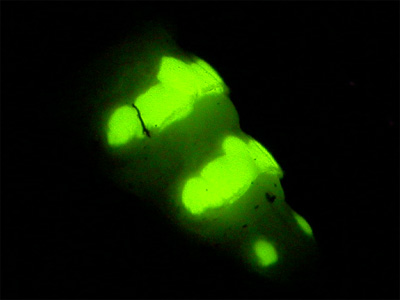 |
|
| ... | ||
| The beginning of June did provide three consecutive days on which it rained, with June 5th being particularly wet during our evening visit. Despite knowing good numbers of females had glowed the previous evening, we only found five females. Clearly the weather was largely the cause of this and this was confirmed throughout the first half of the glowing season on several further occasions. As the season passed it's peak, fewer females stopped glowing because of the weather, and although many July days had some rain, long-lived females would often continue to glow in torrential rain, but often from underneath a leaf or other object. Many females would sometimes never glow, even when conditons were perfectly dry and seemed ideal. What the reason for this is remains unkown, but seemed surprising considering the short life-span of adult Glow Worms and the urgency to reproduce. | ||
| ... | ||
 |
Whilst rain would clearly
stop females from glowing early in the season, it did
seem to be the trigger for the large emergence of females
and males on June 8th. A total of 63 females emerged,
many in the grass strip and there were several instances
where five or more females could be seen within a few
metres of each other. 34% of these females mated the
first evening, 66% had mated within two evenings and 90%
within three evenings. June 8th was responsible for the large peak in numbers shown in the graph on the immediate left. On the night, it provided great excitement at the possibilty of a huge count in the third or fourth week of June, but this never materialised. Three evenings later, female counts had plummeted down to five, before rising slightly again. |
|
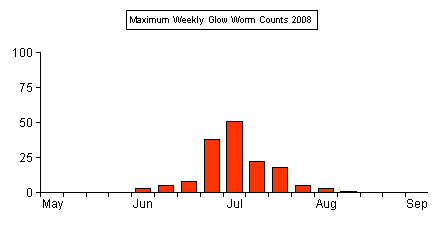 |
This unusually early high
peak was really quite representative of the whole 2009
glowing season, coming 1/2 weeks earlier than in 2008 and
the maximum count of 85 females, was the highest recorded
in the UK this year. Unless other recorders missed
similarly early peaks at other known UK Glow Worm sites,
then Clipstone Old Quarter in Nottinghamshire and one
site in Yorkshire * (Source:-
UK Glow Worm Survey)
had unusually high numbers in comparison to the rest of
the country. Early first dates and an early peak in numbers came despite a Winter with lower than normal temperatures in January and February, compared to recent Winters. |
|
| ... | ||
| The first
females would have been expected about a week or so later
than in 2008, but this was not the case and we could not
make any direct comparisons with our own counts from last
year, as the location of the first two females in 2009
was not covered until much later last year. It is
therefore, theoretically possible that the first dates in
2009 could have been similar to those of 2008. Only
further recording will reveal whether this was a normal
year or a very early one. Despite the very early large
peak in early June, the top graph shows a more general
peak in the last week of June, which was lower than in
2008, but arrived a week earlier. With coverage in 2008
being considerably less than this year, it is possible
that a similar peak was reached in 2008, but was missed. Below:- Satellite image showing the locations of female Glow Worms at Clipstone Old Quarter during the Spring and Summer of 2009. |
||
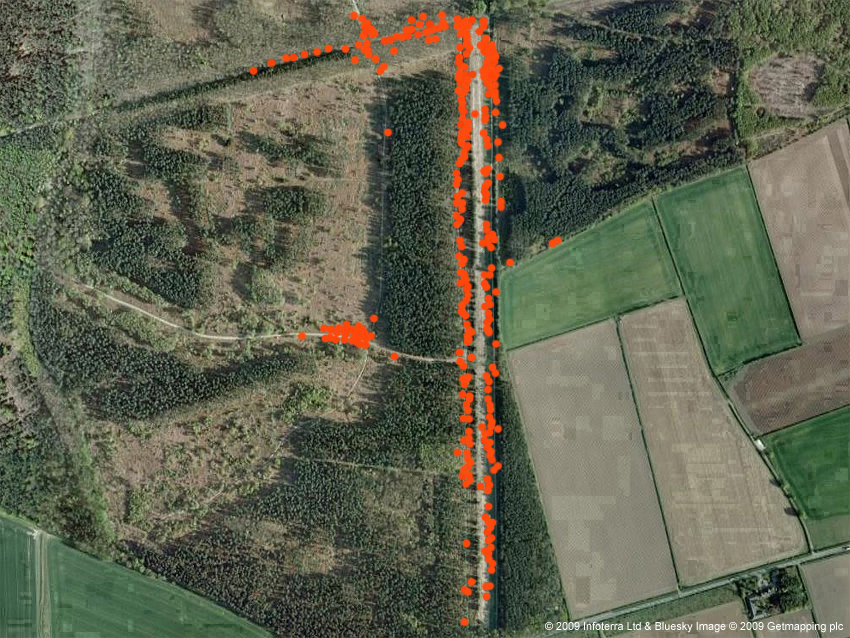 |
||
| ... | ||
| Marking the
locations of every female onto a satellite image of the
site, shows the obvious westward spread of this colony
from the north/south running grass strip and adjacent
forest track. Recent Pine and Birch clearance work seems
to have had little detrimental affect on the colony and a
few old Glow Worm records and anecdotal accounts,
indicate that there have been Glow Worms at Clipstone Old
Quarter for many decades and probably well before the
1900's. One probable threat to the colony over the past few years at least, was the levelling of the forest track after the Dukeries Car Rally each Summer, which must have wiped out many females and larvae. However, following an onsite meeting with the various representatives of the Forestry Comission, this work was carried out with the utmost care in 2009 and was successful in preserving much trackside habitat. A continued westwards spread seems likely over the next few years and there is also the potential for a gradual spread in further areas. It is interesting to note how the colony has not spread eastwards, when there is suitable habitat. Before the adult Glow Worms appeared, we made almost daily searches for larvae. A total of 94 larvae were found between March 9th and May 23rd during evening walks at the Clipstone Old Quarter site in Sherwood Forest, after which we commenced daily searches for the first glowing females. We measured all larvae found and the distribution of larval sizes by week during Spring 2009 are shown in the graph below. The larval total almost certainly included some recaptures and we may look into the possibility of marking larvae found in 2010. |
||
| ... | ||
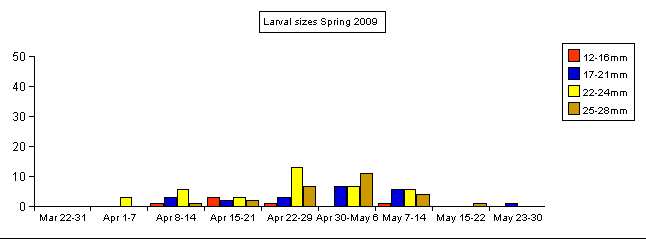 |
||
| ... | ||
| Towards the end of the glowing season, we began to also find larvae along the track in the darkest section of the site (Photograph 02) Larval sizes of the 17 found, ranged from 13mm, right up to one full grown larva measuring 25mm. We were surprised to find any larvae above 20mm, but to find a full grown larva made us wonder if females can occur well into September in favourable years. | ||